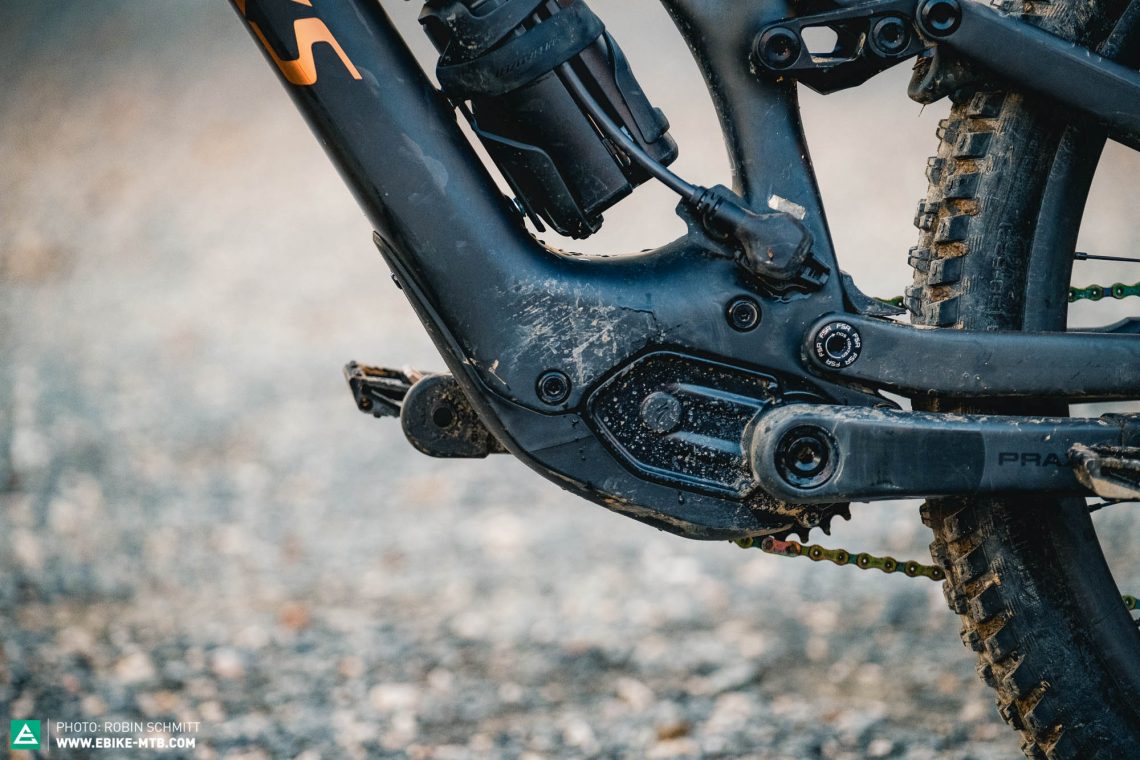With the Specialized SL 1.1, the American brand has worked together with MAHLE to develop its very own motor, designed to be used with light eMTBs with minimal support. Specialized have incorporated smart details into the system, giving the FAZUA RIDE 50 Evation a run for its money.
This motor is part of our big e-mountain bike motor test. Click here for background information and the criteria of this test.

Weighing just 1.95 kg, the lightweight Specialized SL 1.1 motor is housed in a magnesium case. It is used exclusively in Specialized’s own E-road bikes and eMTBs, like the Turbo Levo SL. With 35 Nm torque and a maximum power output of 240 W, the Specialized SL 1.1 is significantly less powerful, but also more frugal than the other motors tested. Just like the Turbo Levo 2.1 motor, which is based on the Brose Drive S Mag, Specialized furnish the SL 1.1 motor with its very own ecosystem. At its heart is the Turbo Connect Unit, which is fitted to the top tube and uses LEDs to provide information about the battery charge and assistance mode. A press of the button also lets you change the support level, meaning that you can ride the SL 1.1 without the remote or display mounted on the cockpit. However, the compact cockpit-mounted remote allows quick and easy mode selection from the bars. The TC display is wireless and displays key ride data. If you want you can display the same data on your Garmin or Wahoo. We’re interested to see when Specialized will use the new Mastermind display of the new Levo in the Levo SL. A further Specialized-typical highlight is the Mission Control app, which allows you to tune all three assistance modes individually as well as navigate to destinations based on your remaining battery and current power usage.
The modular battery concept was also developed by Specialized. The SL 1.1 motor is fed by an internal 320 Wh battery, but you can fit an additional 160 Wh range extender. It weighs approximately 1 kg and is secured with an additional fastener in your bottle cage. In comparison to its fellow, the lightweight FAZUA Evation, the Specialized SL 1.1 is capable of delivering more range, due to both its larger battery capacity and reduced power consumption. In practice, it can manage approximately the same range as a standard Bosh motor with a 625 Wh battery, though that at a slower speed and with more effort from the rider.

The bottle cage also holds the 160 Wh range extender. It weighs roughly 1 kg and increases your battery capacity by 50%.
It should be obvious that with a maximum power of 240 W, that the SL 1.1 is the weakest motor in our test by some margin. But that’s intentional, with Specialized purposefully staying 10 W below the legally allowed limit. In a direct comparison, the FAZUA RIDE 50 Evation is significantly more powerful and as a point of reference, the maximum support of the Levo SL is roughly equivalent to Tour mode of the Bosch Performance CX motor or Eco mode of the Specialized Levo motor. Why so little power? The primary development goal for Specialized was to create a natural ride feel, where the motor wouldn’t be obvious. The 30-strong development team has succeeded in that task and on the trails, the Specialized motor stays pleasantly in the background. The fact that it is providing quite some support in the middle assistance level is only really noticeable due to the hum from the motor. Power delivery is so smooth that more than anything else, it feels like you suddenly have very strong legs. On steep ramps, the ride feel is much more like that of an analog bike than an ebike. Here, the SL 1.1 requires the right gear selection in order to deliver enough support to take the pain out of steeper slopes. This also contributes to its incredibly natural ride feel.

The Turbo Connect Unit shows the battery charge and assistance mode selected. In addition, it communicates wirelessly with the TC display or your Garmin or Wahoo device.

The Mission Control app lets you customise all three assistance modes to your personal preference.
No other motor in the test manages to make the transition above the 25 km/h assistance limit in the strongest setting feel so smooth and seamless. That’s helped by the fact that the SL 1.1 ramps down its output earlier than the other motors, making the transition at 25 km/h that much smoother. However, that means for mixed rides with ebikes playing in the Bosch-class, you’ll need to put a lot of effort in to keep up with others on the flats.
Our conclusion
There’s absolutely no doubt that the Specialized SL 1.1 motor is exemplary when it comes to integration, connectivity and a natural ride feel. Its compact construction makes it possible to create a truly lightweight ebike, with handling that is almost identical to an analog bike. If you want to get to the top of your climbs at top speed without breaking a sweat, you’re looking in the wrong place. Thanks to its natural character, every ride becomes a workout.
Tops
- incredibly natural ride feel
- small and light
- integration and connectivity of the TCU
- customisable motor setup
- modular battery
Flops
- loud hum
For more information head to specialized.com
This motor is part of our big e-mountain bike motor test. Click here for background information and the criteria of this test.
Brose Drive S Mag | Bosch Performance Line CX | FAZUA Ride 50 Evation Firmware 2.0 | SACHS RS | Yamaha PW-X2 | Shimano STEPS E8000 | Shimano EP8 | TQ HPR 120S | Specialized SL 1.1
Did you enjoy this article? If so, we would be stoked if you decide to support us with a monthly contribution. By becoming a supporter of E-MOUNTAINBIKE, you will help secure a sustainable future for high-quality cycling journalism. Click here to learn more.
Words: Photos: E-MOUNTAINBIKE team









